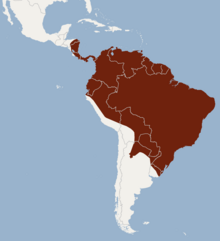Shoreline ear
| Shoreline ear | ||||||||||||
|---|---|---|---|---|---|---|---|---|---|---|---|---|
| Systematics | ||||||||||||
|
||||||||||||
| Scientific name | ||||||||||||
| Myotis riparius | ||||||||||||
| Handley , 1960 |
The sea moth ear ( Myotis riparius ) is a bat in the smooth-nosed family that is found in Central and South America.
features
The species is a small member of the genus with a head body length of 40 to 54 mm, a tail length of 31 to 43 mm and a weight of 4 to 7 g. It has 32 to 38 mm long forearms, 7 to 9 mm long hind feet and 11 to 14 mm long ears. The slightly woolly fur on the top is made up of hairs 5 to 6 mm long. It varies in color from dark brown to orange-brown, while the underside is covered by light brown fur. The dark brown ears of the sea meager are narrow and the pinkish brown skin is visible on the muzzle. The flight membranes are colored black. The sea mouse-ear is very similar to the black mouse-ear ( Myotis nigricans ). The distinctive feature of the bank mule ear is the laterally located and rarely visible second premolar in the upper jaw.
Distribution and way of life
The sea moth ear occurs from eastern Honduras to northern Argentina and Uruguay . The species is often observed in evergreen forests, in partly deciduous forests and over adjacent open spaces. It usually reaches a height of 1000 meters and rarely 2000 meters.
The animals form colonies in the resting place and hunt insects.
status
There are no threats to the sea mule ear. It is listed as Least Concern by the IUCN .
supporting documents
- ↑ Myotis riparius . In: Don E. Wilson , DeeAnn M. Reeder (Eds.): Mammal Species of the World. A taxonomic and geographic Reference. 2 volumes. 3. Edition. Johns Hopkins University Press, Baltimore MD 2005, ISBN 0-8018-8221-4 .
- ^ A b Reid, Fiona: A Field Guide to the Mammals of Central America and Southeast Mexico . Oxford University Press, 2009, pp. 153 ( Myotis riparius ).
- ↑ a b c Myotis riparius in the endangered Red List species the IUCN 2017. Posted by: Barquez, R. Perez, S. & Diaz, M., 2016. Retrieved on February 14 2018th
